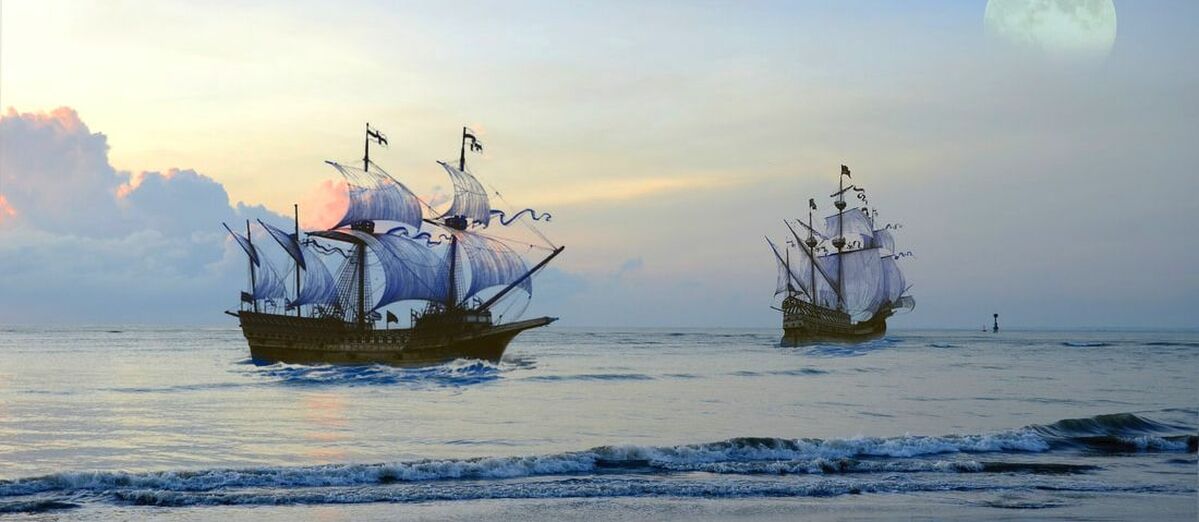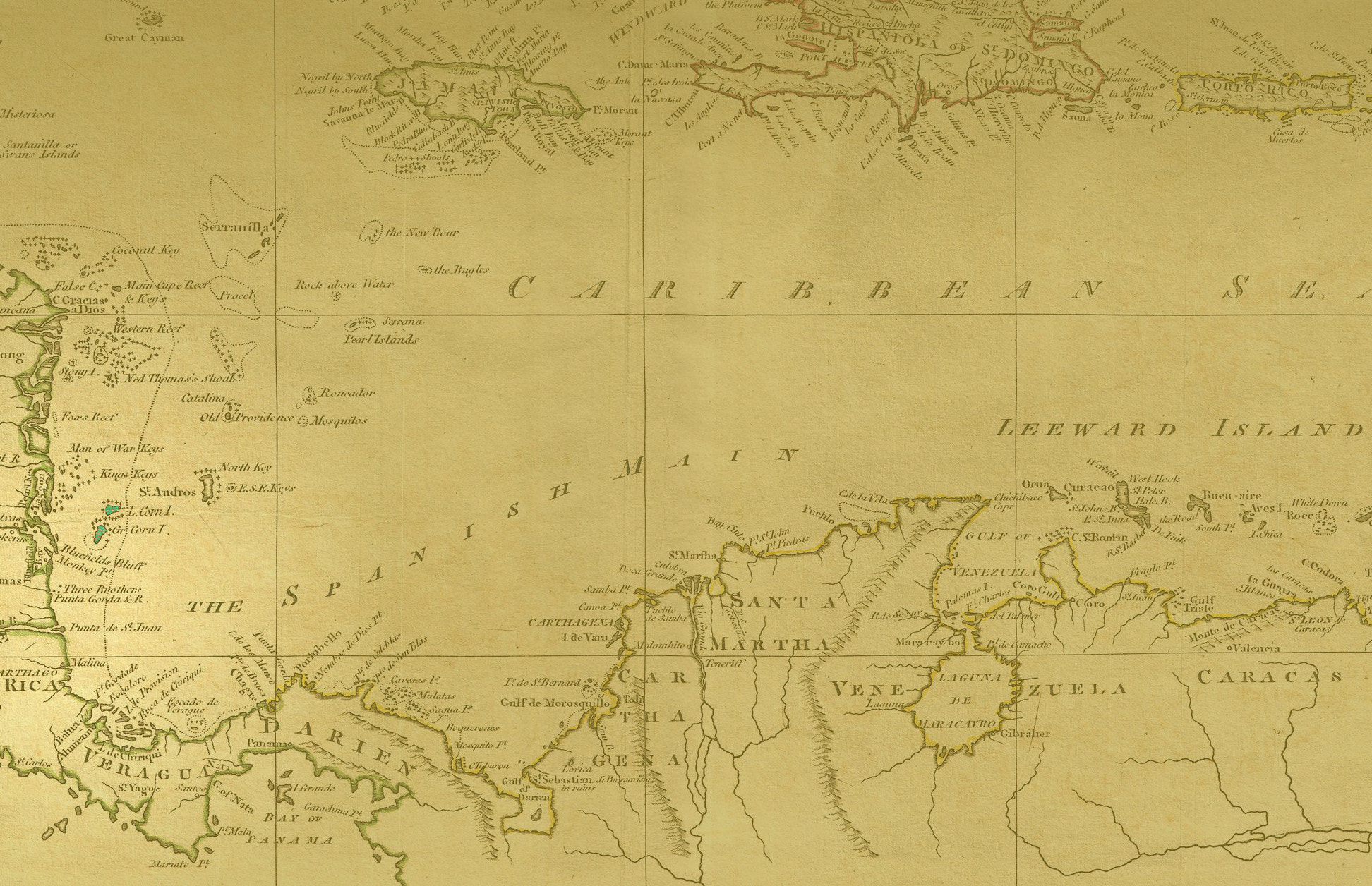
1600 - 1660
• First Recorded Contact •

The Corn Islands appears in Alexander Olivier Esquemeling's "The Buccaneers of America". The author, a dutch pirate says he visited the island between 1600 and 1666 as a surgeon/barber. He describes the native population, the Kukras, as being short and stout with black hair, round faces, small eyes, eyebrows that fell across their eyes, flat foreheads, wide noses, thick lips and sinking jaws. A subsequent account, in 1681 by english privateer William Dampier describes the inhabitants as bare-footed, copper-colored and naked except for a loin cloth tied around their waist.
Later accounts would provide nothing more than a memory of these people, with the islands, as with much of the other territory held by the Kukras now in the hands of their main adversaries, the Miskitos.
1700
• Settling Down •

A consensus of the island's cultural carriers agrees that The Corn Islands were then settled around 1700 by British (English, Welsh and Irish), and Scottish immigrants coming from Jamaica with their slaves. According to oral accounts the boat's captain was Gil Patrick Quinn, and the sailors: Sammy Downs, Obidiah Campbell, Herbert Campbell, and Mr. Hunter, though other evidence to confirm or support this is hard to come by.
Settling and then seeking to derive sustenance and income from the lands they now inhabited the new islanders developed some of the islands most suitable growing land into plantations. Slavery was the mechanism for providing the labour to tend the crops and each plantation owned between a handful and twenty men and women to do this, though it was estimated that one land owner, Mr Robert Hodgson owned over 100 at one point.
There are still reminders of the islands' history of slavery with the Daruda Slave Well as well as remaining evidence of the land border Slave Walls built to separate plantations. On the site of the new solar array there was once a walled garden used to cultivate herbs for cooking.
1700 - 1841
• Island Cotton •

The principal export crop from The Corn Islands was cotton, and this was used to support the islanders newly formed colony. The excellent growing climate and trading possibilities along the mainland coast as well as with other Caribbean islands and further afield allowed life to take root here and remain like this for many years to come. Liverpool was the principal destination for the cotton laden ships and its pristine cargo ultimately destined to be the robes and garments of the British Empire and her trading partners in every corner of the world.
Hodgson had pigs goats etc.
1841
• Emancipation from Slavery •
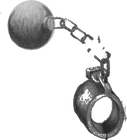
On August 27th Colonel Alexander McDonald, Superintendent of British Honduras, on behalf of Queen Victoria and King Fredericks visited The Corn Islands to declare freedom for all the slaves. In celebration the newly freed men and women went to the swamps to hunt for land crab to make into a great soup, they fashioned gourds into bowls to receive the bounty of the feast they had prepared, and the tradition is one which is still annually celebrated and revered today.
The proclamation itself brought freedom to 98 slaves on the island as declared in the document recording the event. There is a vein of thought that would suggest however, that some of the men and women in bondage on the island were not present at the proclamation, possibly through fear of the event itself or possibly as some of the plantation owners did not bring the slave families to be freed. This information is assumed from a discrepancy in the number of slaves known to have been present at an earlier time in the islands history (200+) and the number of people who were listed as having been freed on the day of emancipation.
The British Crown had offered to pay recompense of £25 Sterling to the plantation owners for each person now granted freedom...though this was never paid.
1894
• Nicaraguan Sovereign Territory •
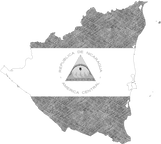
The Corn Islands formally requests to become part of Nicaragua, and officially becomes incorporated into the country in 1894 after almost 200 years under British rule. The choice comes as a result of the islanders disillusionment with the administration of the island from afar. The island becomes part of Nicaragua, a move which also puts and end to Colombian and Costa Rican claims over the island.
Obiaism
1894 onwards
• A New Direction •
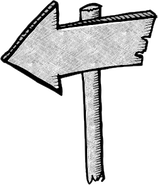
While political change had increased stability for the islands' in the long term, much about daily life went along just as before. A number of Christian churches had been established on the island, education was beginning to become more accessible and the provision of medical care was no longer as sporadic as before.
Twenty years after the incorporation, Nicaragua and the US would come to an agreement which will see the island being leased for US strategic purposes, namely protection of the Panama Canal. While plans were put in place, no effect other than the building of a lighthouse on Little Corn was felt. The lease was annulled and full control taken back.
A mounting voice was rising from The Corn Islands during this time asking for more autonomy to decide on matters that were particular to the island and not have to fall in step with regulation that was more designed for the mainland. In 1940 Corn Island finally becomes a Municipality and began conducting its own affairs much to the delight of the islanders.
Until 1988
• The Coconut & Lobster Industry •

Great Corn Island becomes a coconut palm plantation, used for export to the US market, principly by the Franklin Baker Company. This continued through until one terrible evening in 1988 when Hurricane Joan ripped through the islands and razed them. With barely a tree left standing it was the death knell for the coconut industry.
Conversely, the Lobster industry on both The Corn Islands began in the mid 1960's with the discerning American palate finding a fondness for this bountiful fruit of the local seas and has continued to grow steadily ever since. The island now has two companies who sell the islands' lobster to clients across the world.
1988 - 2001
• Hurricane Joan and Rebuilding an Island •
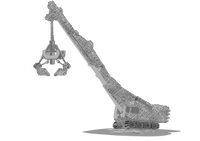
In the aftermath of the hurricane The Corn Islands had been decimated and a period of rebuilding and restructuring were required to diversify the economy from the staple of copra, the sought after flesh of the coconut and also to rebuild the homes and infrastructure lost in the tempest. Tourism was to prove to be the sector within which new expansion and investment could take place and allow it to compliment the island's other industries and both public and private enterprises were set up to maximise this latent potential.
2001 - 2010
• Modernization and an Eye on the Future •

Infrastructure projects to develop the islands in concert with the burgeoning tourist economy saw new investment in roads, electricity & water supply, waste management, transport links, and the airport. With plans also put in place to develop a new hospital, the islands' move into the 21st century has lifted both native living standards and visitors enjoyment manyfold.
2011 - Present Day
• The Tourist Trail •

While tourism has been around prior to the 2010's its greatest increase happened more recently with Little Corn island in particular enjoying something of a hidden, untouched gem status among travellers, owing to the laid back lifestyle, stunning natural beauty and lack of motorised transport. Great Corn, saw more of a gradual increase over the same time but now the two compliment each other to provide a combined Caribbean destination for every traveller.

